13 Trello Tips and Tricks for Small Businesses
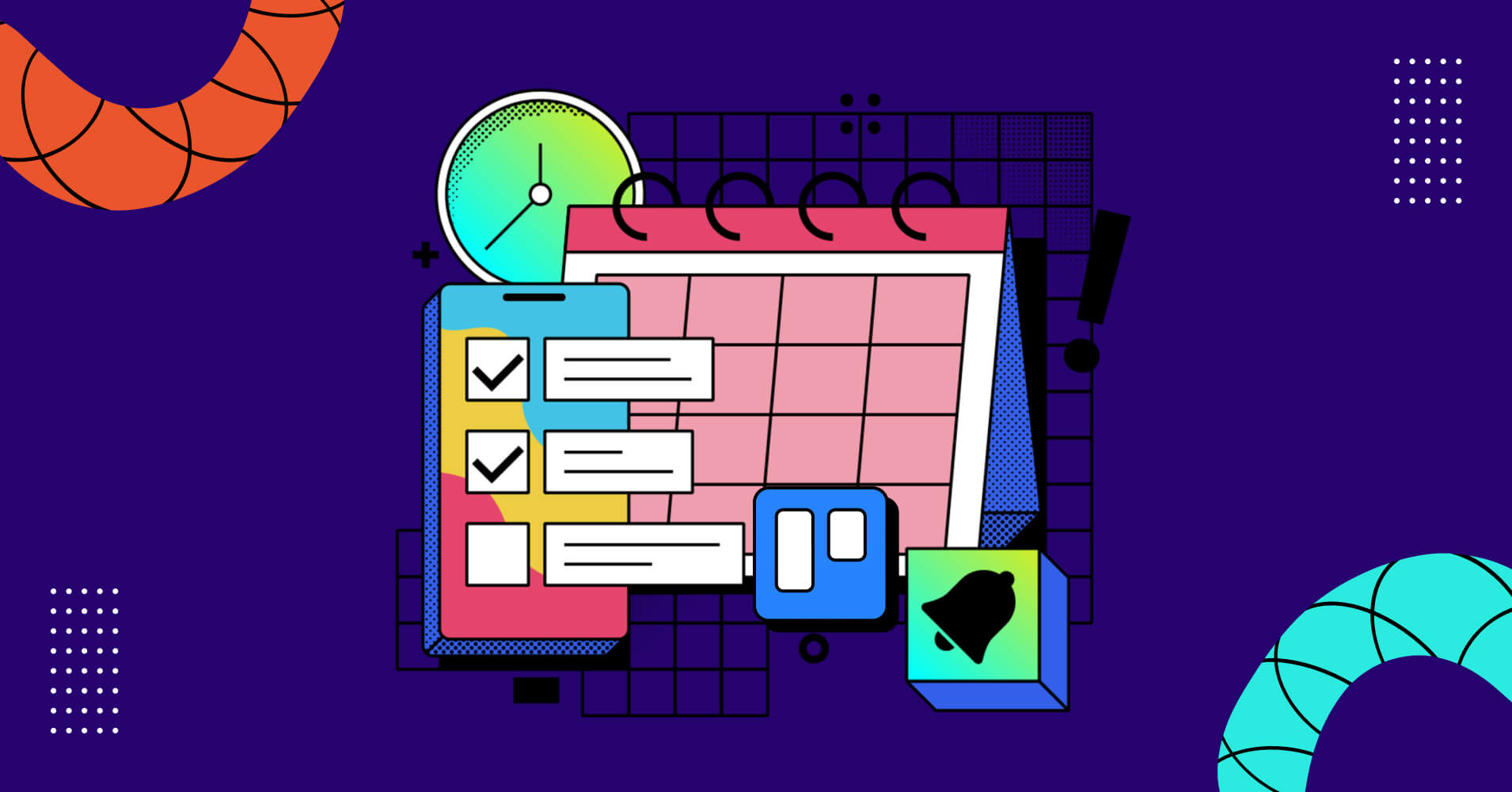
Here’s a challenge. Tell me, you haven’t been in one of these scenarios. You have your new project all planned and mapped out inside your head for your business operations, or your boss asks you to plan a project. You have this amazing idea, but you feel like simply pitching it at a presentation isn’t enough. This is your project, and you want to make sure that there are no loose ends.
Well, good news for you. These smart Trello tips and tricks will help you manage every small detail of your project with precision.
How to use Trello for project management
The Kanban layout of Trello boards allows you to sort, categorize, and subcategorize your tasks into multiple lists and cards within those. It helps you achieve lean management by increasing your efficiency and minimizing waste of resources like time, energy, and budget. It also makes organizing look like a dream with board background images, card images, colorful labels, and stickers.
Here’s how you can use different Trello project management tools and templates to run your projects like an expert. And the best part is, even if you’re just a beginner, this is as easy and helpful for you as it is for a dedicated user.
Trello project management tool
Sign up for Trello if you haven’t already, and create boards on your Trello workspace according to your needs. You can have one board per project or activity. Create multiple lists within the board, you can create the lists as to-do, work in progress, done, etc. Then list your to-do activities as cards inside the to-do list. Once you start working on a task on the to-do list, move it to the work-in-progress list, and so on.
You can assign members and due dates to each card, and add a card description, that will help you keep track of who’s in charge of which task and give the members incentive to get a task done within time.
We’ve created two sample Trello boards in our Trello workspace for real estate project management. One is for keeping track of all available properties in LA for brokering. Inside that board, We’ve categorized lists as properties for sale, properties for rent, etc. Inside the lists, We’ve created separate cards for houses, apartments, condos, and studios. Now we can list the properties in the card description according to their categories.
Besides, there are countless power-ups for multiple functionalities like analytics, marketing, management, backup, etc. You can review the number of installations to find out which power-ups are trendy for each function.
Trello project management template
You can create your Trello board from scratch or you can also choose your desired one from many templates. Trello has its templates categorized so exploration becomes super easy for you.
Step 1
Tap on the dropdown on templates from the top bar, then go to Explore templates. Or, go to Create and then Start with a template.
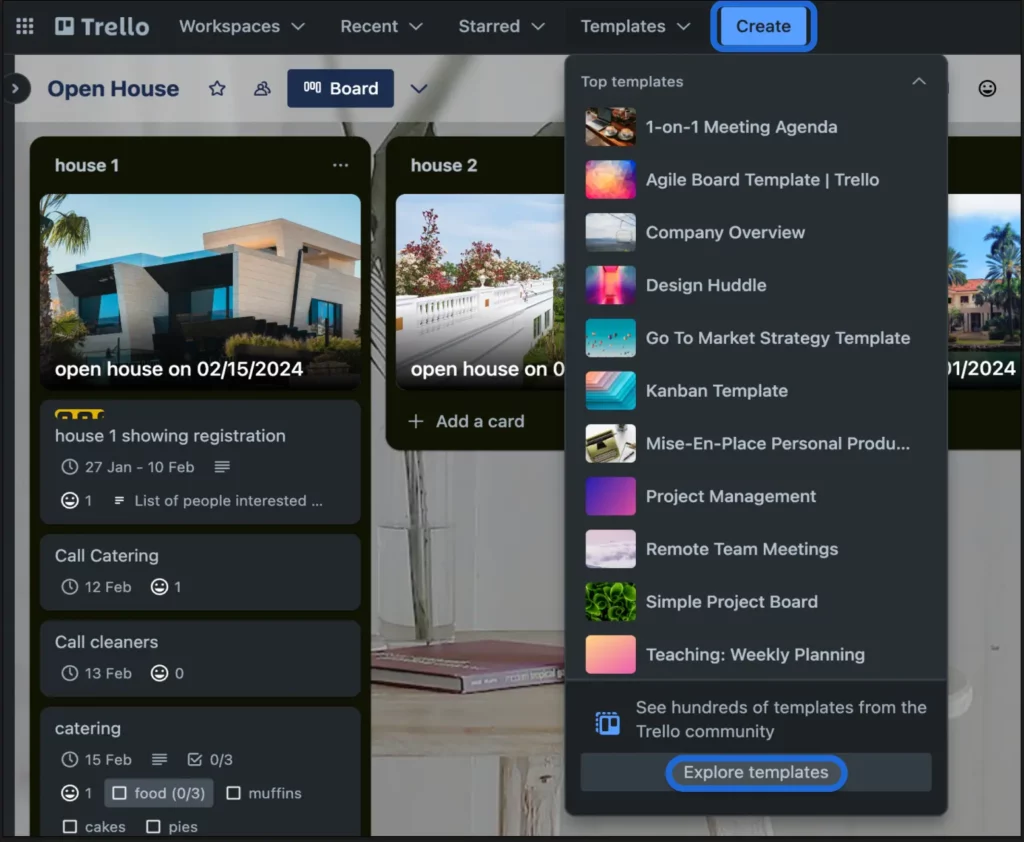
Step 2
You can see the categories on the menu on the left, choose from there, or search for your niche in the Find template box.
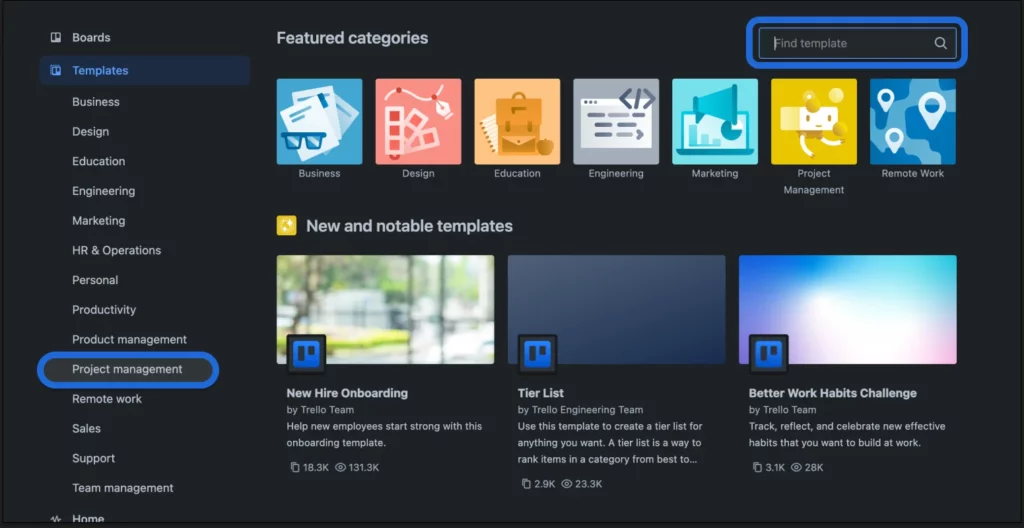
Step 3
Now, tap on the copy button of your desired template.
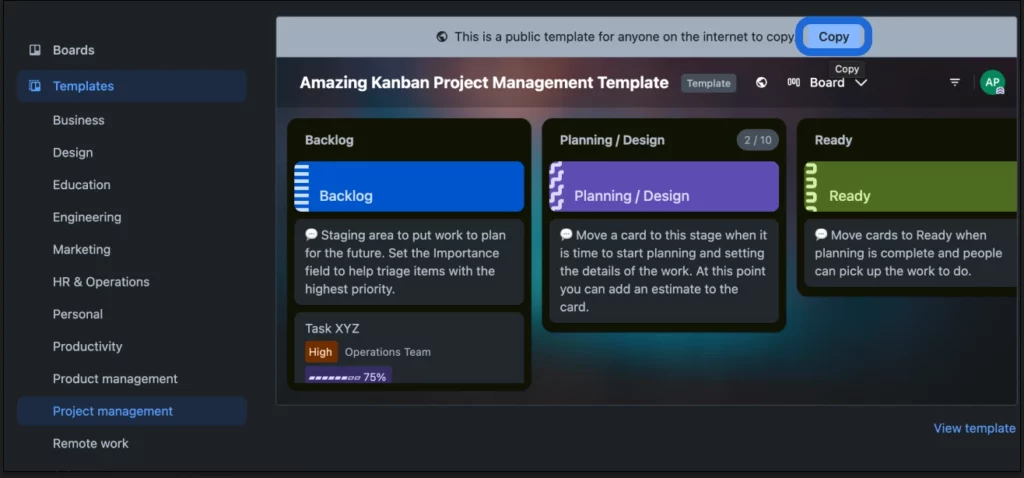
Step 4
Finally, go to the Create option and you have a Trello board with that template.
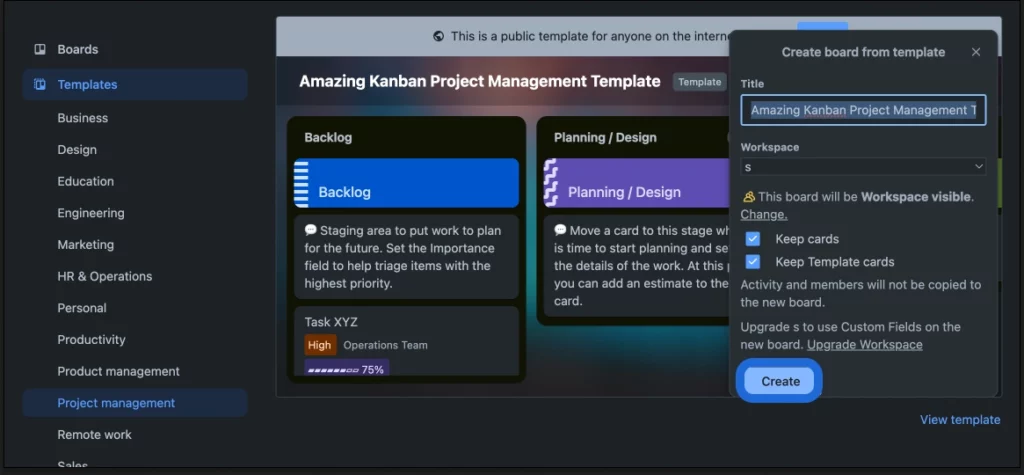
Apart from the ones at Trello, you can find other free and premium templates as well if you search Google.
Now that you know how to manage a project using Trello, it’s time for some super brilliant Trello tips and tricks to take your projects to new heights.
13 Trello tips and tricks for small business projects
They say, work smarter, not harder. So, how can you work smarter? The answer is, by putting in only as much effort as necessary. It’s a competitive world and you do not want to waste time by doing things the lengthy way. What you require is useful hacks to become efficient.
Want to manage your business projects effortlessly? Learn these cool Trello tips and tricks to get the most out of your projects, collaborate with your team seamlessly using this lean management tool, and make your projects flawless.
1. Link multiple Trello boards for easier access
Linking your Trello boards helps you in ways more than one. It allows you easy access to related boards, and if you’re managing a lot of boards, it helps you keep track of all the boards of a particular group.
Now, how can you link multiple Trello boards?
Simple, you can do it in just 3 clicks.
Step 1
Go to the board you want to access from a different board. Copy its URL.
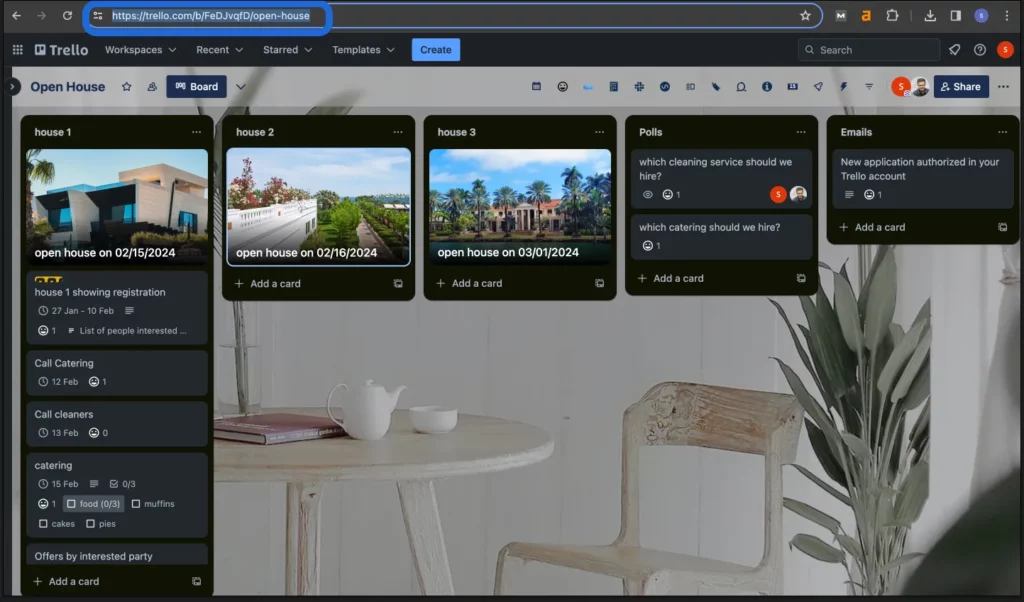
Step 2
Now go to the board you want to link it to. Create a new list and add a card or simply add a new card to an existing list. Paste the link on that card and tap on the Add card option.
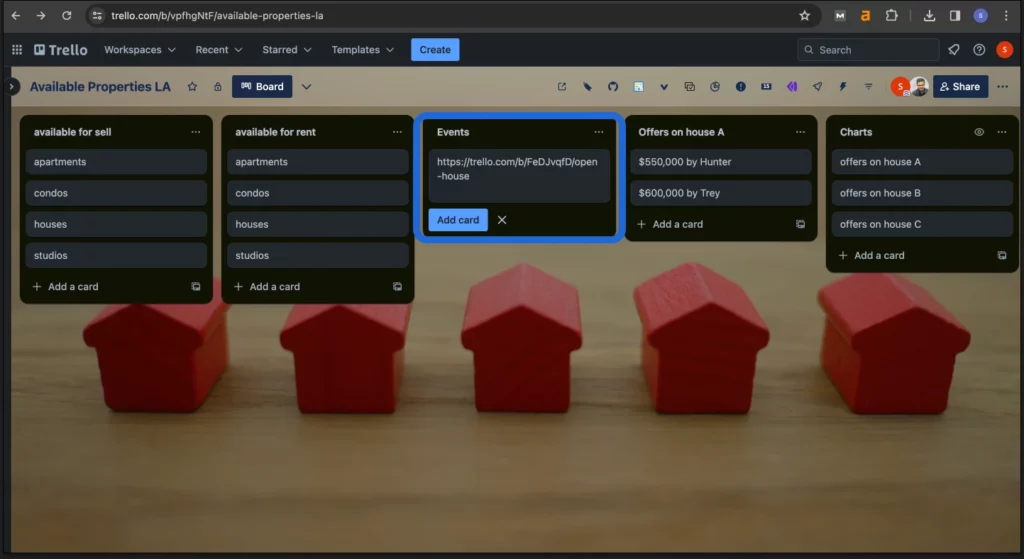
Step 3
Now you’re all set. This is what the other board will look like inside your card. One click on it and you’ve already switched boards.
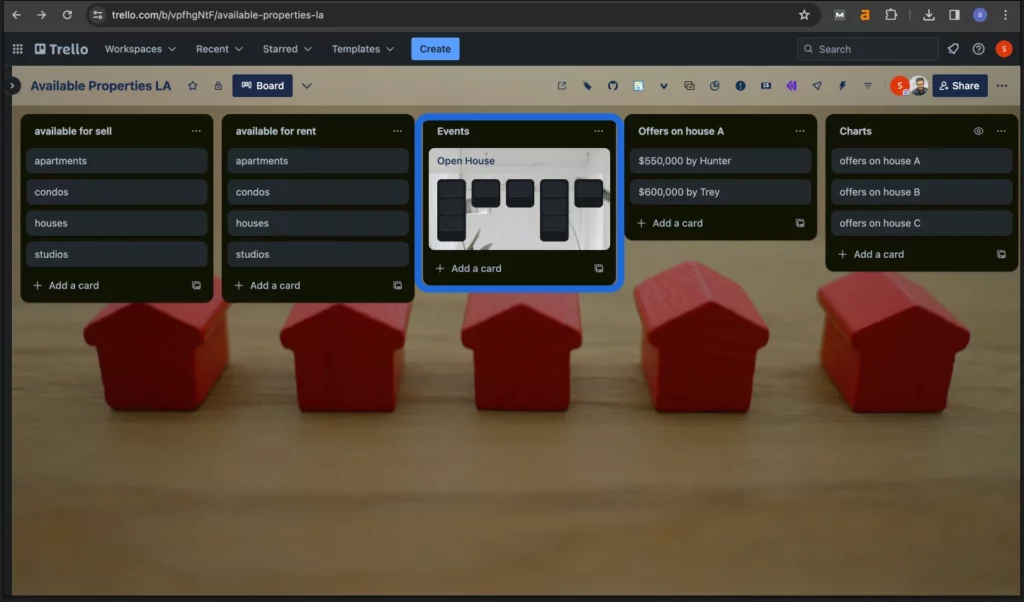
Now, what if you don’t want to move to a different board, instead you want the other board to open in a new tab? Well, I have a workaround for that as well.
All you need to do is go to the power-up option from the bar, select add power-ups, and search for bookmarks in the search bar. Add the bookmarks power-up.
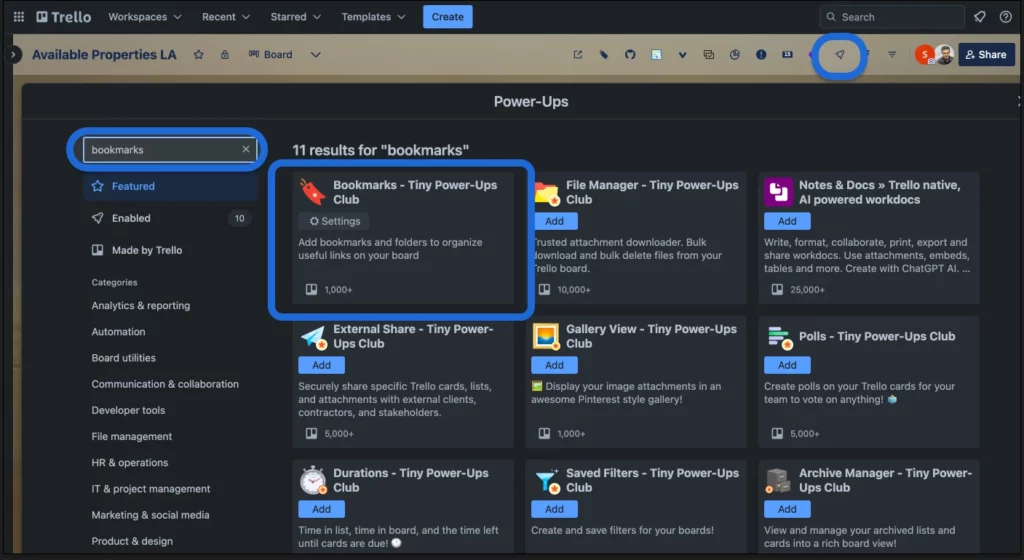
Step 1
When you click on the bookmarks icon from the menus, a box opens up. Create a folder. We created one called all events.
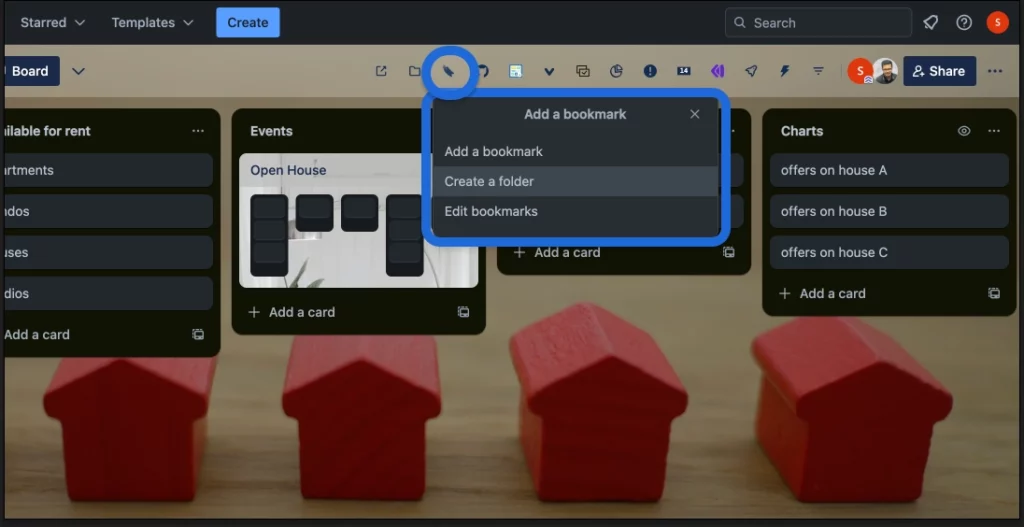
Step 2
The folder you just created for bookmarks shows on the menu as well. There, you paste the link and name your bookmark before adding it. And you’re done.
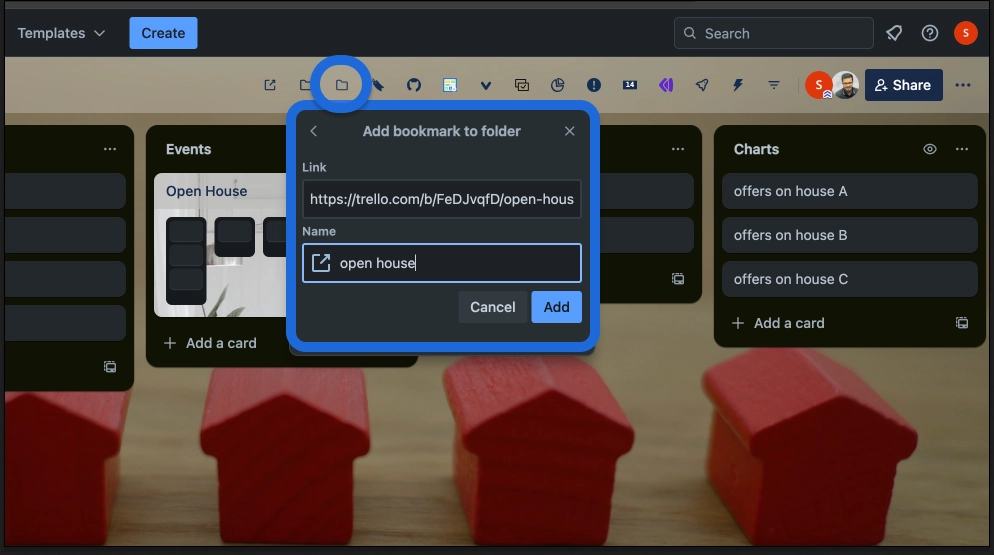
Go to the respective folder, and click on the desired bookmark to open the bookmarked board in a new tab.

2. Learn Trello keyboard shortcuts to save time
If you’re working all day on your computer, chances are you’re not used to lifting your fingers from the keyboard. In that case, it’s your lucky day because you’re about to get comfortable with the Trello keyboard shortcuts.

Furthermore, if you’re fluent with markdown, Trello has you covered there as well. Check these out.
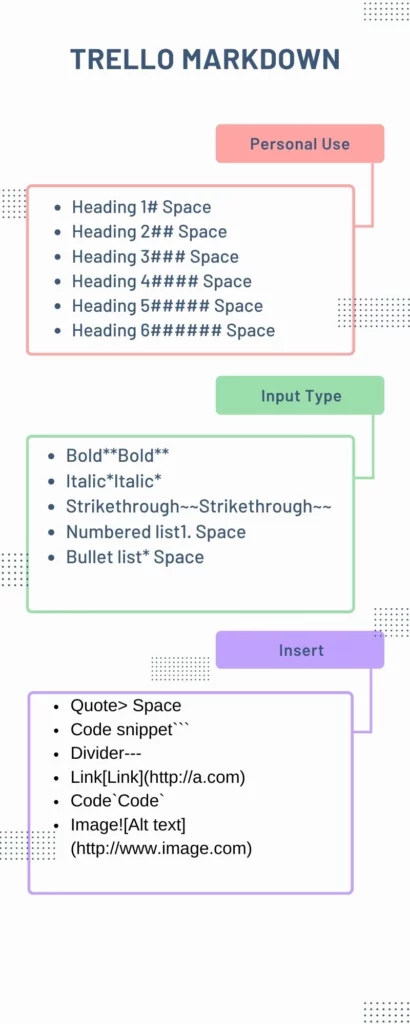
You can have these images saved, or you can access these shortcuts from your Trello cards without breaking a sweat. Just go to the description box on a card and tap on this question mark, and you get a list of all the shortcuts.
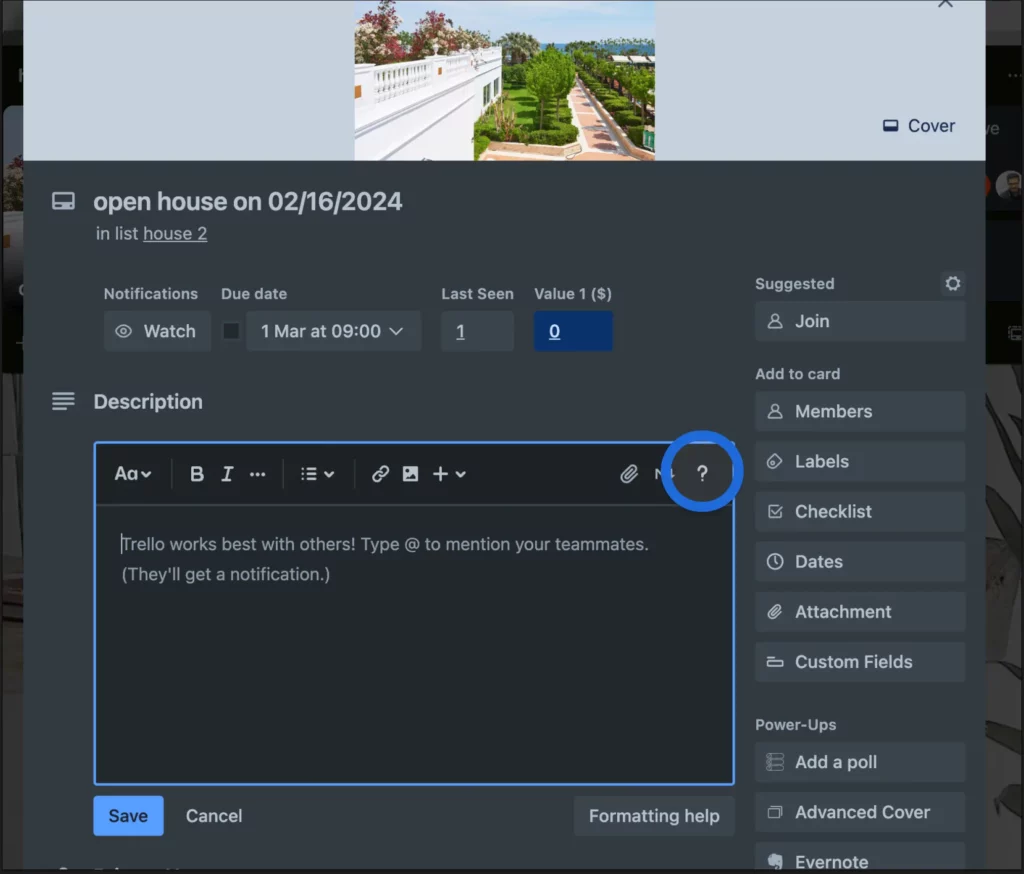
Or simply click ⌘ + / t or, ctrl + / t from your Trello workspace to open the shortcuts at any time.
3. Make a visually appealing board using Trello calendar
Trello calendar lets you set the due date for a task. You can add it to all your cards or lists to manage multiple due dates with ease.
There is a checkbox beside the due date, which, when you check, marks the task as completed. You can also add automation, where Trello reminds you at your preferred time when a due date or time is approaching.
But the most amazing tip about the Trello calendar is you can open a card from it, and add details to the card. And when you switch to the calendar view, it shows you all your cards like post-it notes.
However, if you’re using the Trello free version, which only supports board view, I have this cool trick to remedy that. Find this calendar power-up from your Trello power-ups and add it to your board.
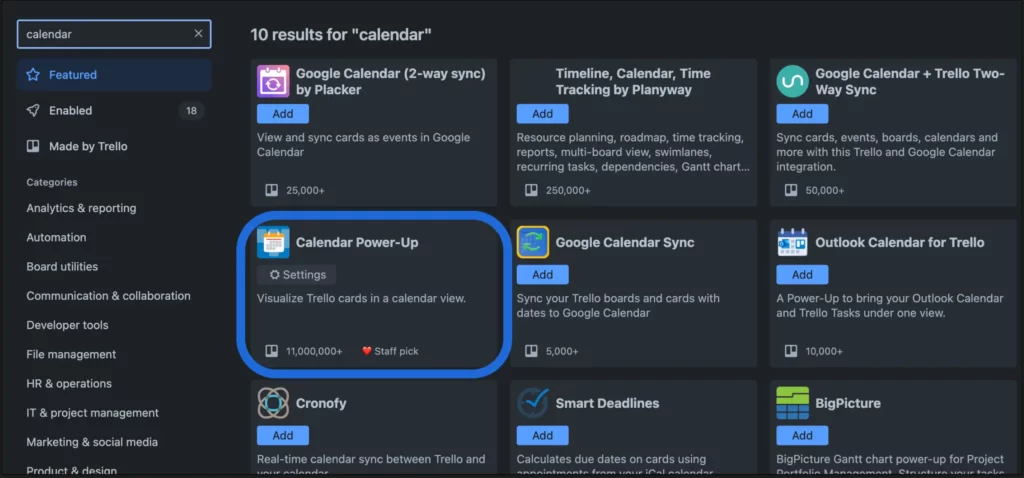
It’ll be added to your upper menu board. Click on this icon for the calendar view. And there, you can see all your cards on their due dates.
To create a card from the calendar, simply click on the date you want to add the card to, and the Add a card option will pop up. Click on that to customize the card details like at what position and on which list you want it, or the due time.
The card will be added to the preferred list, and from there you can add a description, a label, and other details to it.
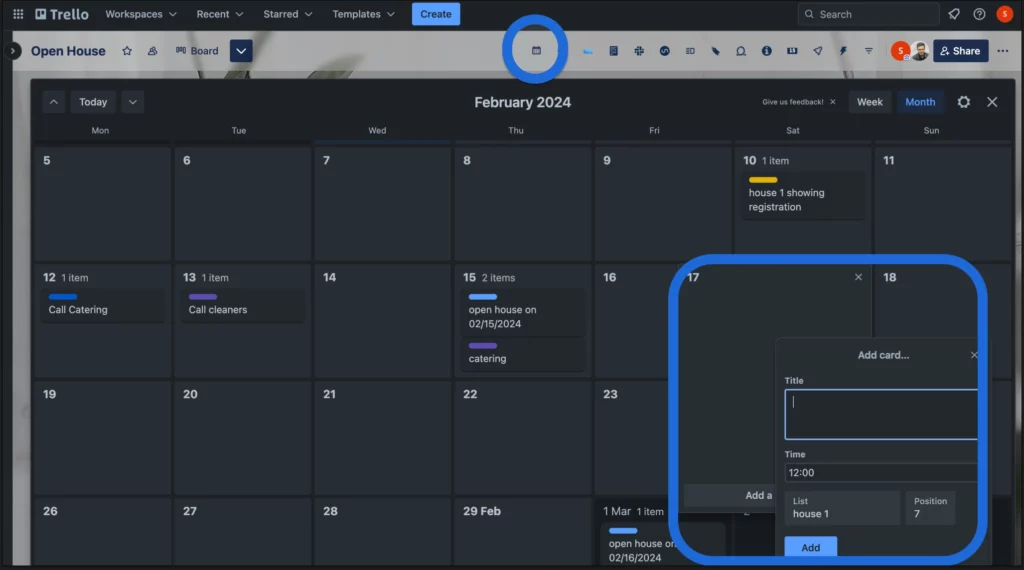
4. Rely on Trello voting and polls for team decisions
Want to leave some decision-making to your team members? You can do that in one of two ways on Trello cards.
If you want them to decide on a single result, create a poll on a card. You can create a list called polls, and add separate cards for separate polls under that list.
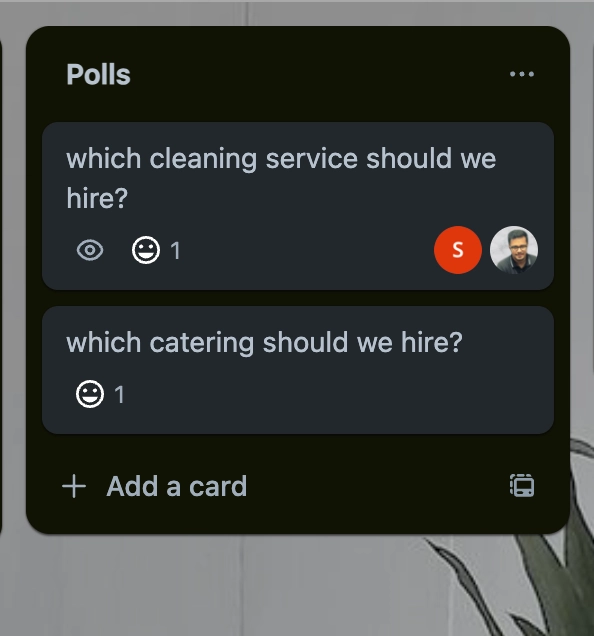
So what do you need to do to use this amazing feature? Simple. Just another power-up. Add this one from Trello power-ups, and you are all set.
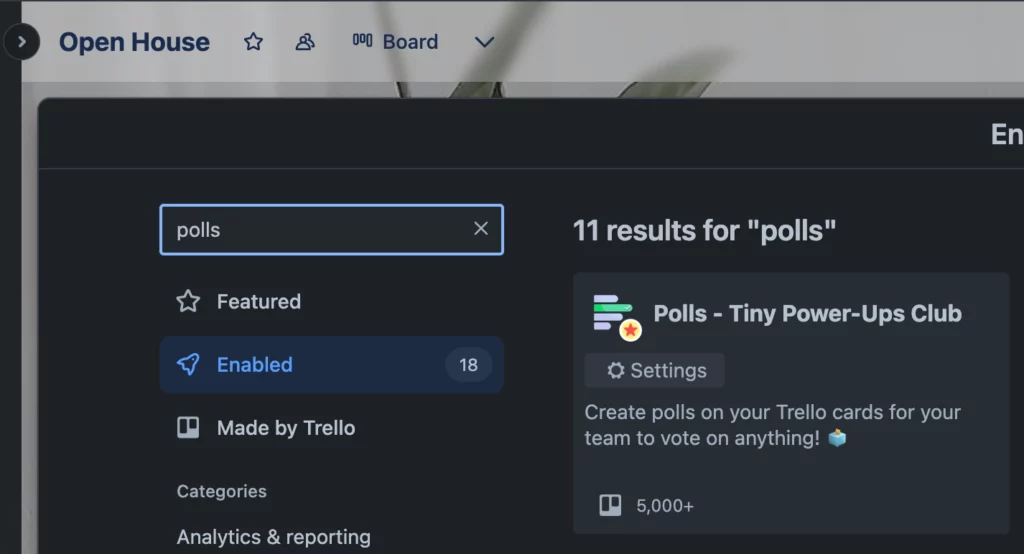
The only thing left to do is create polls and vote on those. Just go to cards and select add a poll from power-ups. Add what you’re voting on, fill in the options and you’re all set. You can also allow voters the freedom to add options or vote for multiple options.
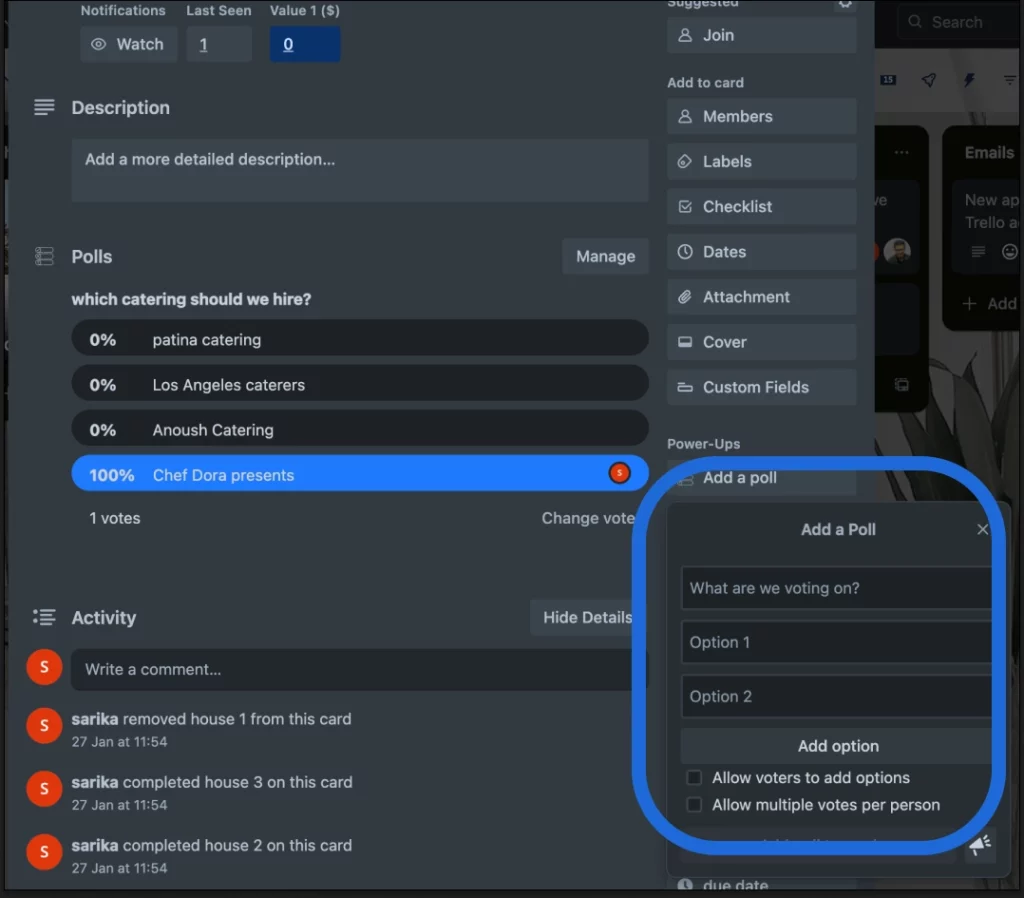
Now what if you want the votes to show up front so it’s easier to count and keep track of? Well, there’s a solution for that as well. You need this cool voting power-up for that.
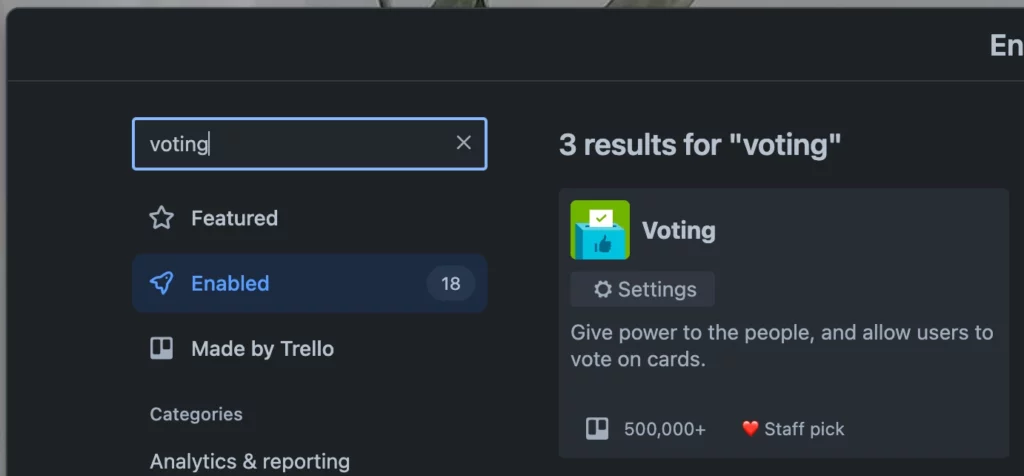
Create a new list, and name it with what you want to vote on. And add options as single cards. Open the card you want to vote on and the vote option will appear in the actions menu on the bottom right of the card.
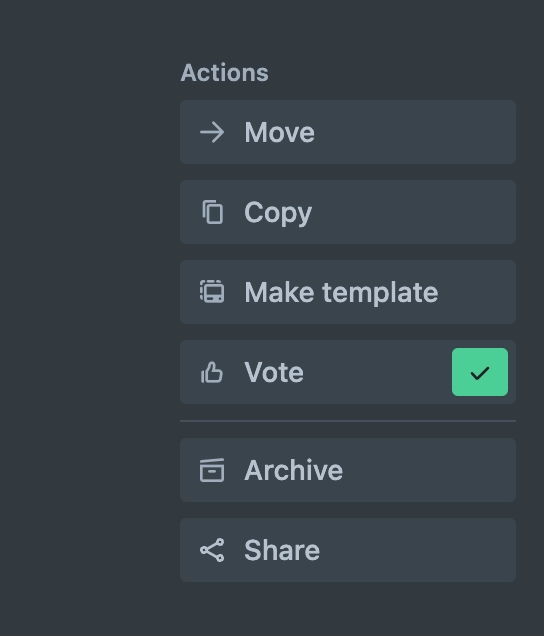
Check the vote box and your voting is done. This is what the list will look like after voting.
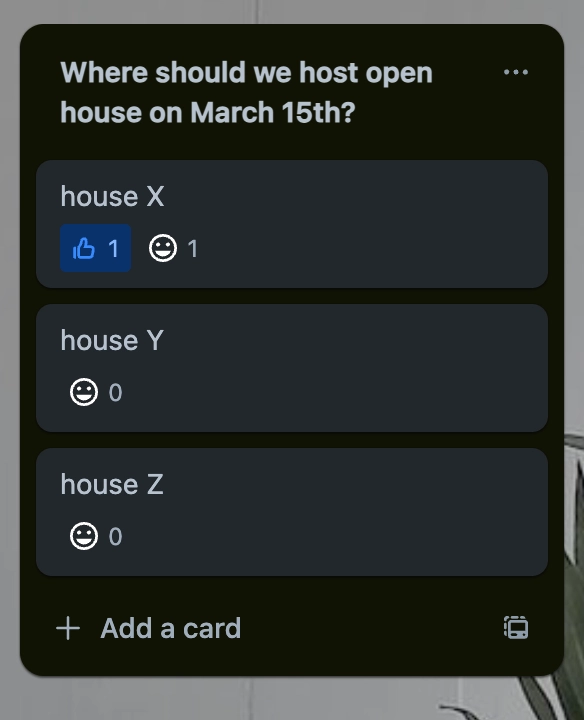
5. Tag your cards with colorful labels for better organization
If you happen to like color coding all your collections, then this hack is absolutely for you. You can use multiple colorful labels to sort and organize your cards as per their category. This is completely about your convenience.
You will find labels in the add to card section when you open a card. There are several colors to choose from, and there’s also a colorblind-friendly mode.
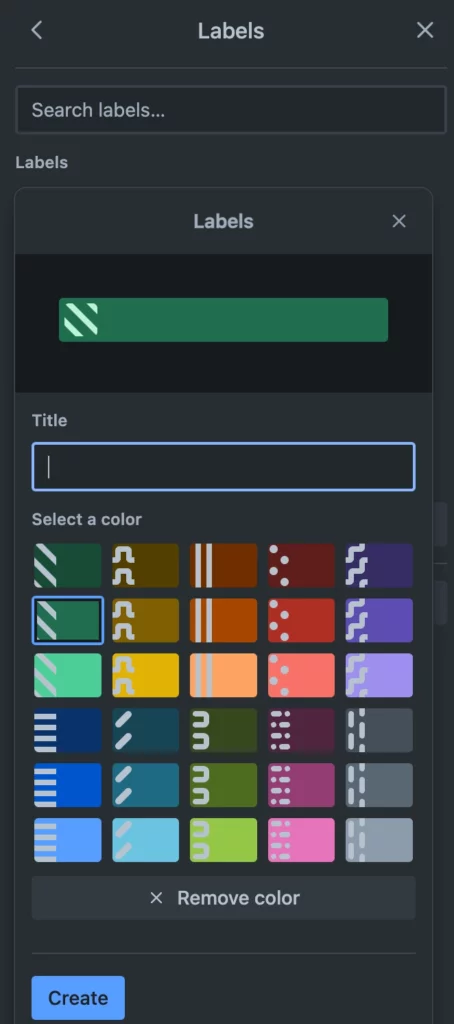
For our cards, we created labels that transition from deep red to deep purple according to their priority level. You can also tag them like to-do, doing and done, or how urgent they are, or anything else you like.
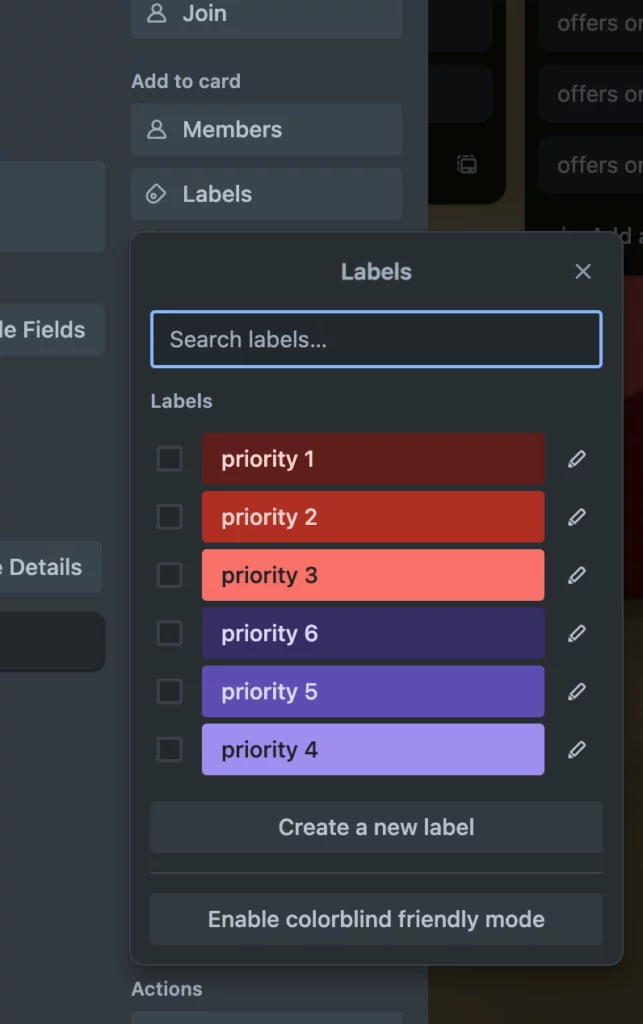
6. Learn what you can do with the sort list feature on Trello
There are three ways you can sort a list on Trello, and all of them are invaluable in their use. So, how do you sort a list? Go to a list and click on the three dots in the upper right corner. Select Sort By from the dropdown menu that pops up.
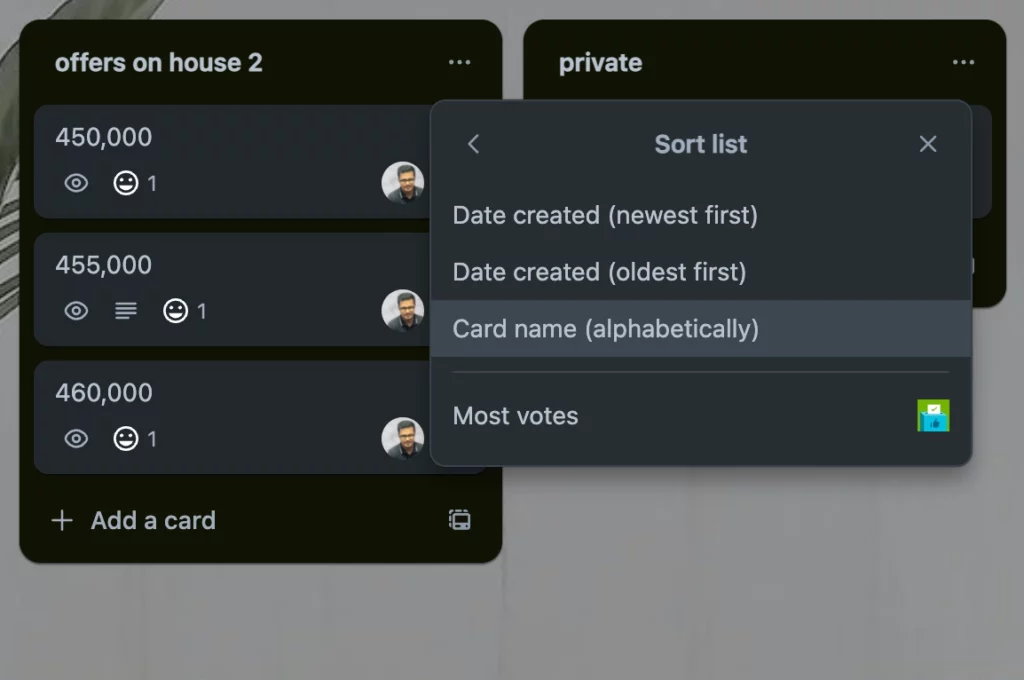
First, let me tell you about the one I found most useful (and I promise you, it is a very crafty trick). Of course, you can put first names on card titles and the names will appear alphabetically if that’s how you sort the list.
But what else can you do with it? Well, when a card gets filled automatically this tip is your friend if you want to sort through the data by just scanning it.
For Example, on my website, people make offers for the properties they take an interest in through a form along with their contact information. And the offers become the titles of my Trello cards while their contact information goes to the card description.
Anytime I sort the list alphabetically, the highest offer appears at the bottom of the list, with the lowest one appearing at the top.
If you’re wondering how I create Trello cards from form submission, that is another neat trick I’ll come to later on. For now, let’s see where a list sorted by date created is appropriate.
Remember when we were creating polls on cards? Well, whenever you sort that list by the date created (newest first), new things to vote on will appear at the top of the polls list, and you can easily find out if you’re missing out on a voting opportunity.
Go to your lists right now and see how you want to sort them.
7. Use Trello checklists to keep track of your activities
Trello checklist is a very handy tool when you want to go through your list item by item. It basically works like a notepad and when you check the boxes, the strikethrough text makes it look like you manually cut them with a pen.
Open a card on which you want to add a checklist and on the right-hand bar, you’ll find the option checklist under add to card. Let me show you a sample checklist we’ve created about the steps needed to be taken when a property is listed. You can also search for other Trello checklists for real estate templates.
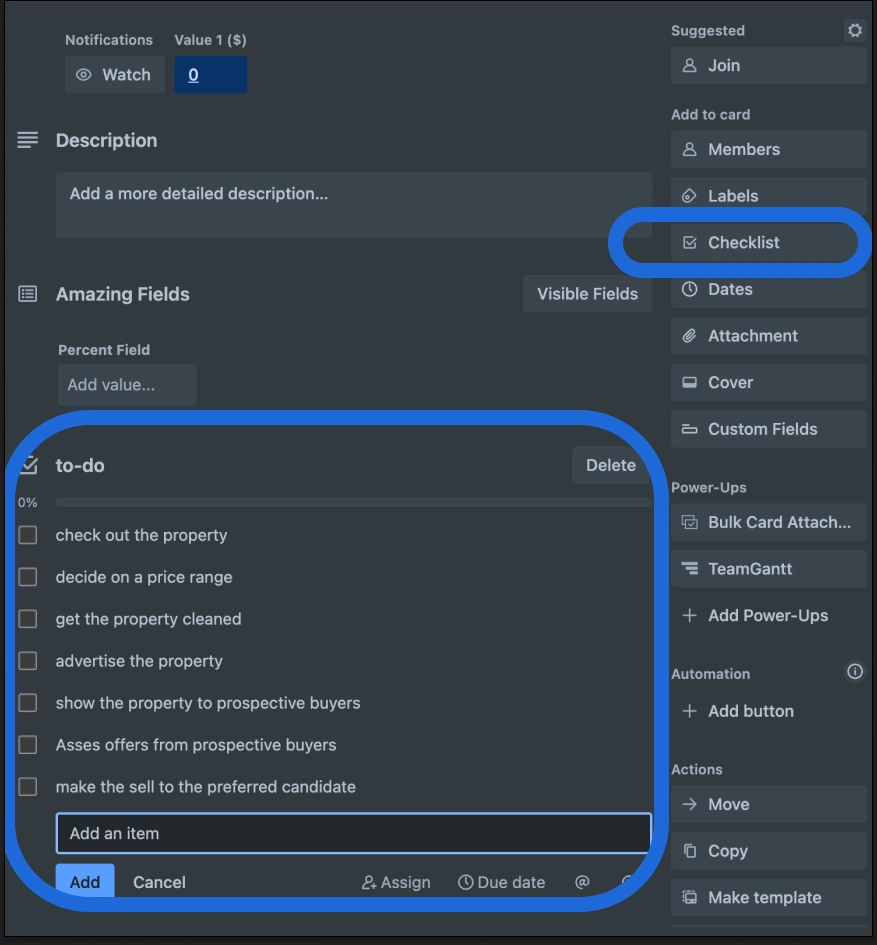
And when you start checking items, it shows up on the card front how much of your work you’ve done.
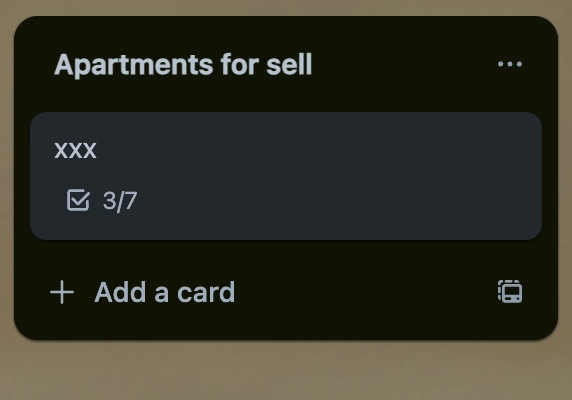
8. Let Trello automation do your repetitive work for you
When it comes to Trello tips and tricks, automation is the master key to hundreds of enchanted locks. You can literally make Trello work for you like an assistant. In this section we’ll show you two separate automation.
Say, you want to follow the same standard steps for all the properties you list. Therefore you need to add the same checklist to all the cards titled with properties.
So, would you copy and paste the same checklist every time you include a new property or would you rather let Trello do it for you? It’s a no-brainer, the second one.
Let me show you how to use Trello automation (formerly Trello Butler) for that.
Step 1
Tap on the three dots on the top right corner of the list and go to create a rule under automation.
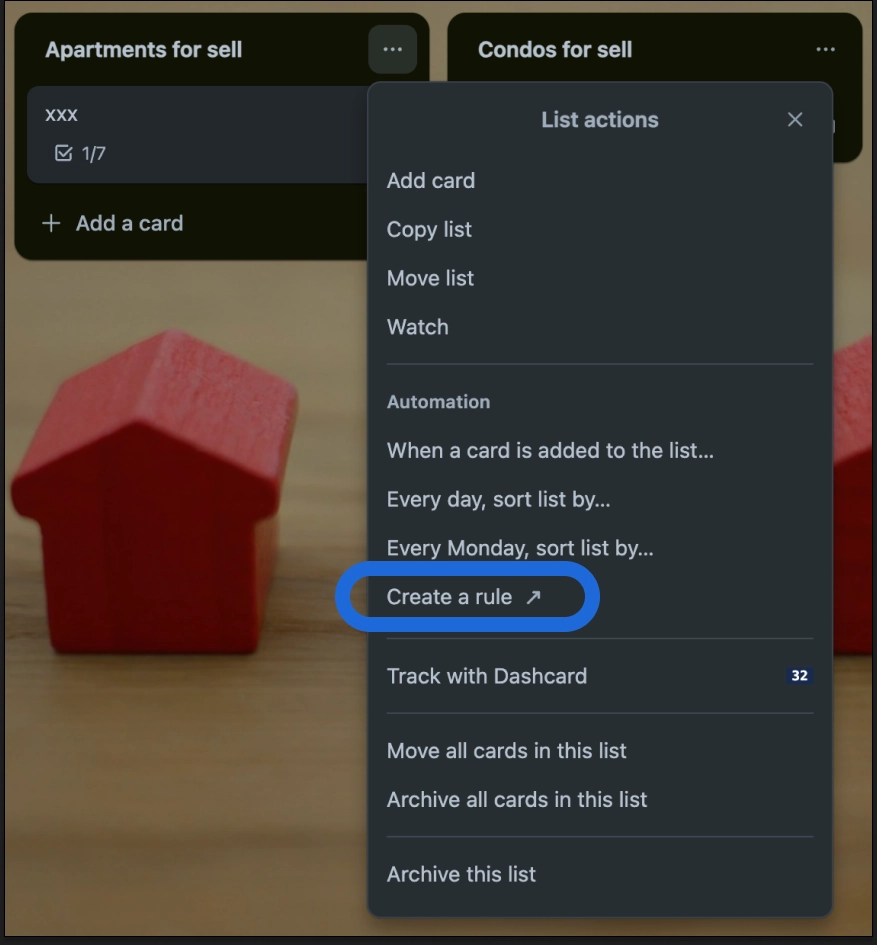
Step 2
The Create a rule option takes you to this page. From there, you have three more steps. The steps work as conditions. For some particular incident, some particular action will occur.
Click on Add Trigger.

You can choose from any of these triggers and customize the options, then click on the plus button to add the trigger. Next, you’ll be led to the actions page.
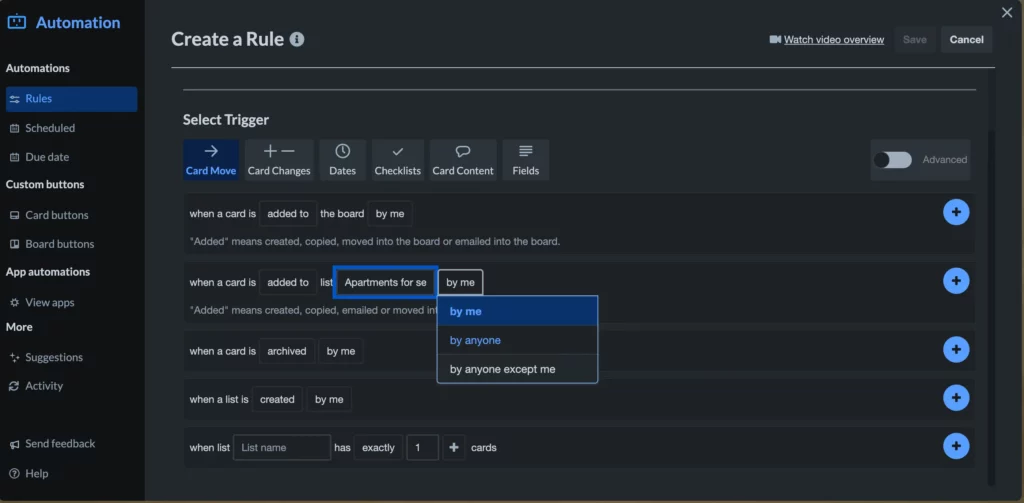
On the select action page, we chose checklists. You can select any or multiple from these according to the functionality you require.
To add checklists this way, enter the name of the checklist you want to add, and in the next box, enter the name of the card where you want to create the checklist. If you want to rename the checklist, there is an option for that as well in the third box. Finally, click on the plus button.
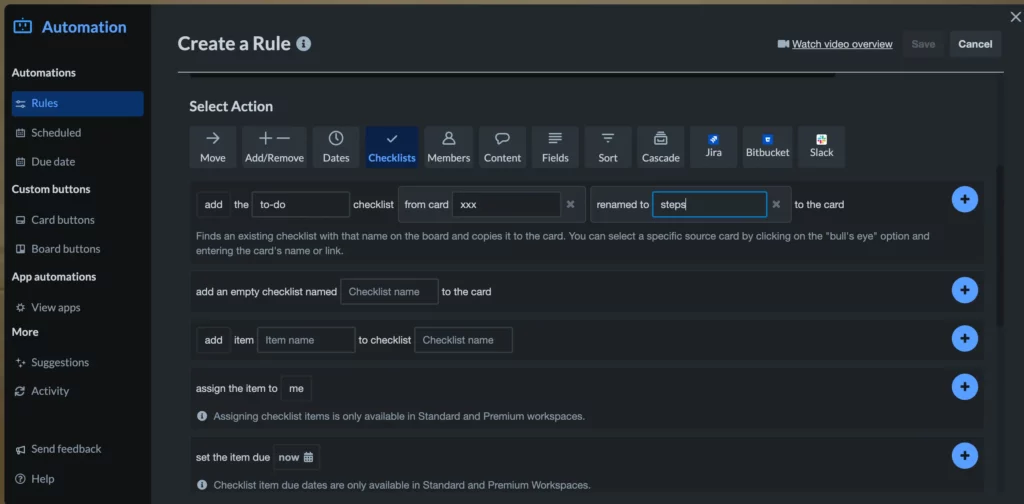
From there you’ll be led to the save automation page. You simply review the action and the trigger, and click save, and the rule gets automated.
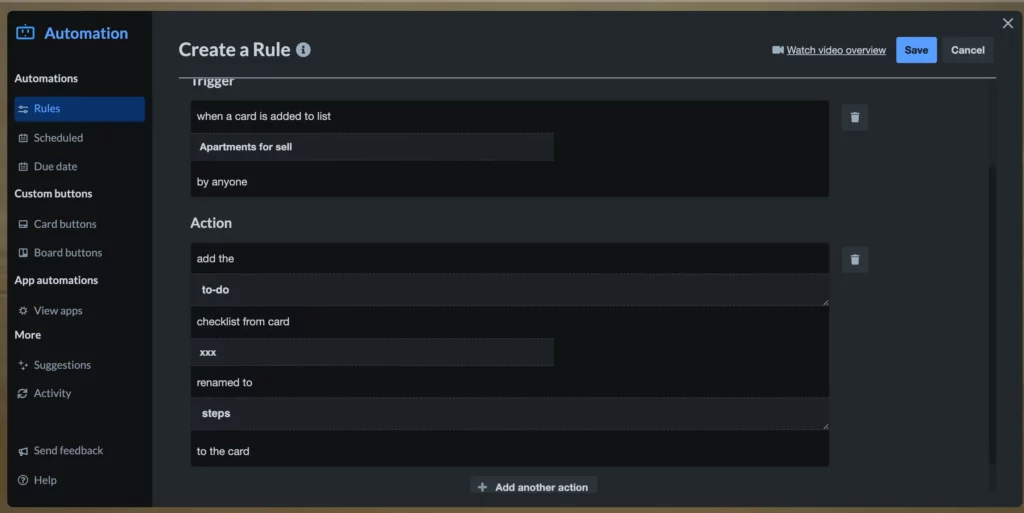
Now what if you want to automatically move the new properties you enlist to the top of the list? Let’s see how that’s done.
Go to when a card is added to the list from under automation. And change the variables like this.
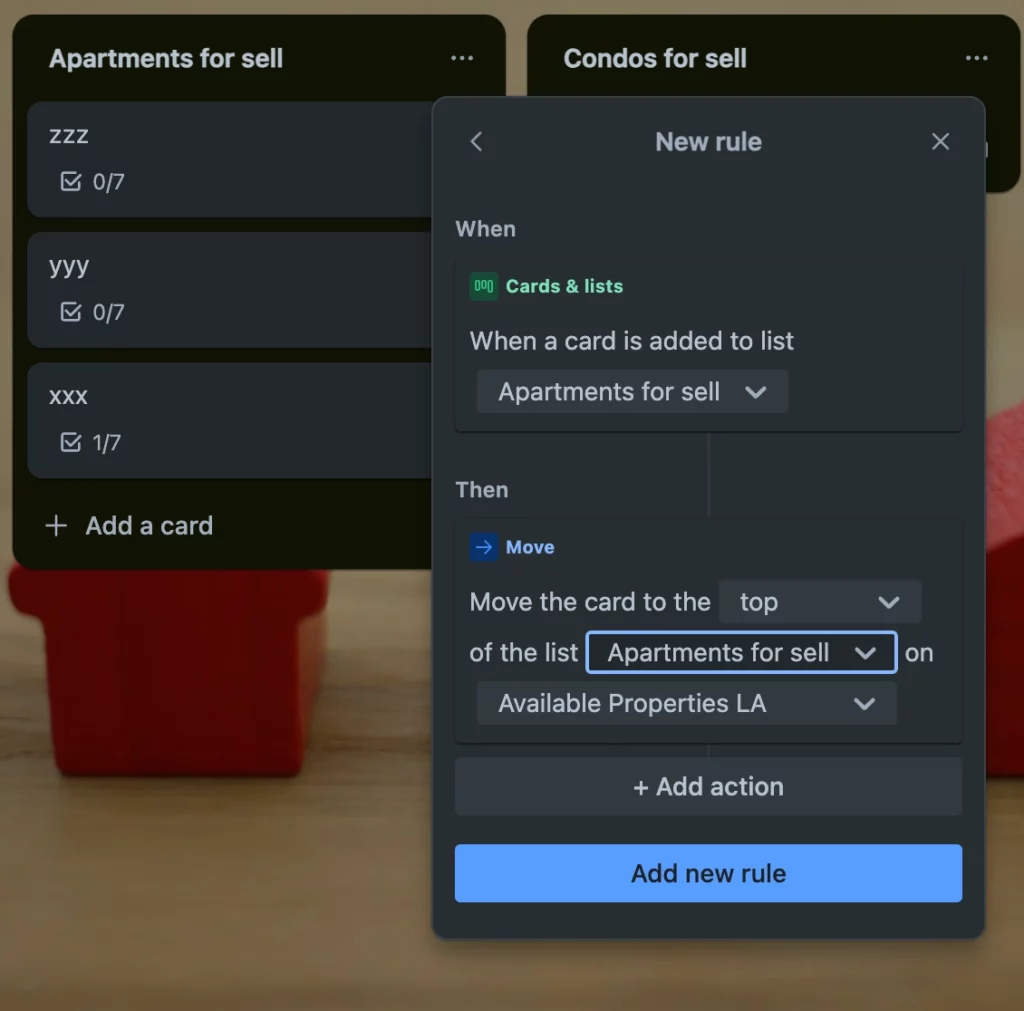
Now, when we add new cards to this list, this is what the list looks like.
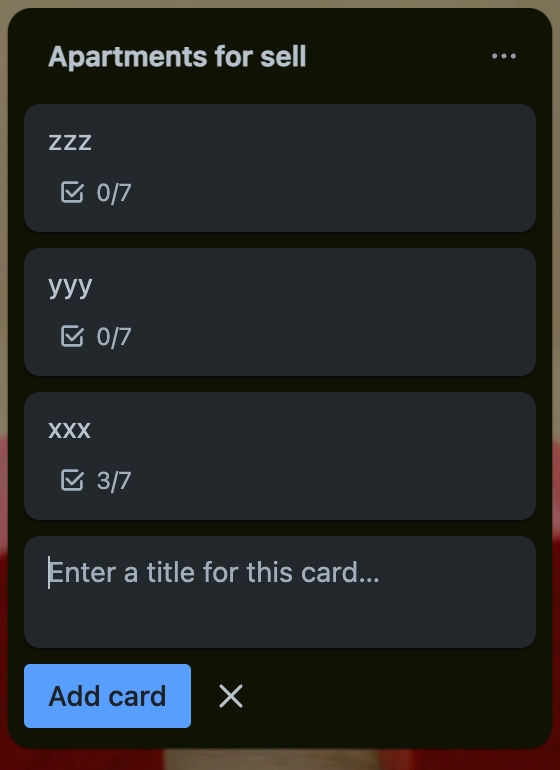
You should definitely explore all the automation rules to utilize Trello to its full potential. Have a look at their automation limits for different freemium plans.
9. Checkout this neat email to board hack
Yes, you can bring your emails to your Trello board as separate cards simply by forwarding it. The subject of the email becomes the card title and the email body goes in the card description.
Let’s see how it’s done.
Step 1
First, you decide a list on which you want the emails to go to. For example, we created a new list called Emails. Then, click on the three dots in the upper right corner of the board.
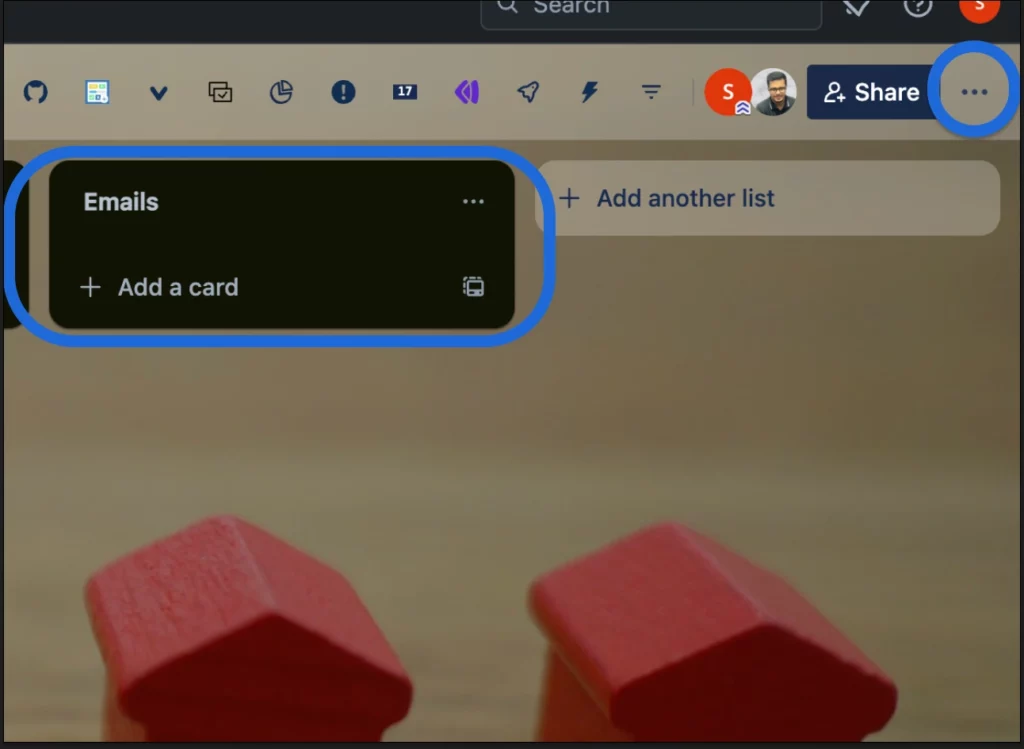
Step 2
From there click on the email to board option. In the menu that appears, you’ll find an email address provided by Trello. That’s where you have to forward the emails to. Copy the email address, or generate a new one.
Next, select which list you want the emails to appear in from the dropdown menu, and whether you want them on top or bottom of that list.
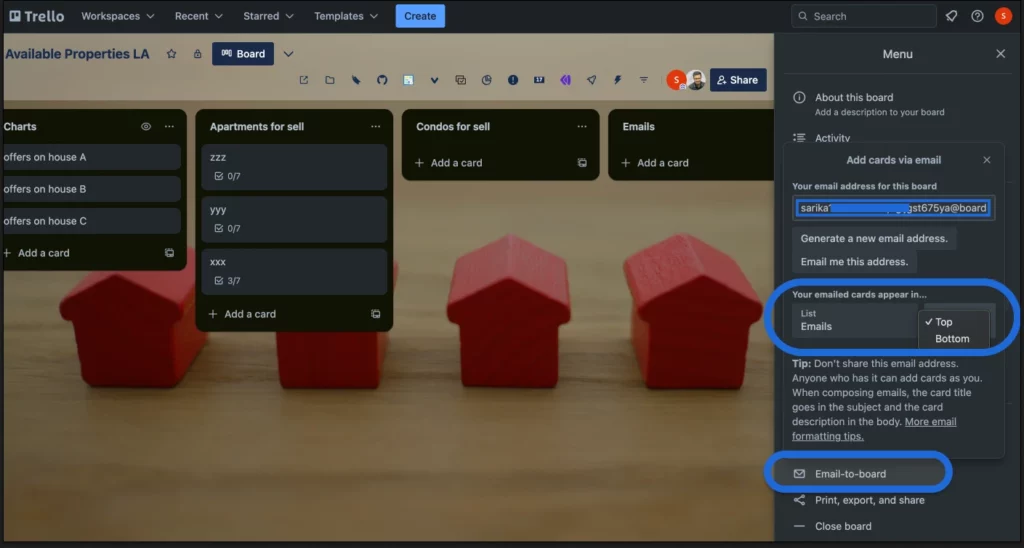
step 3
Now, go to your email and select an email you want to move to this board. Forward that email to the address you just copied from the board.
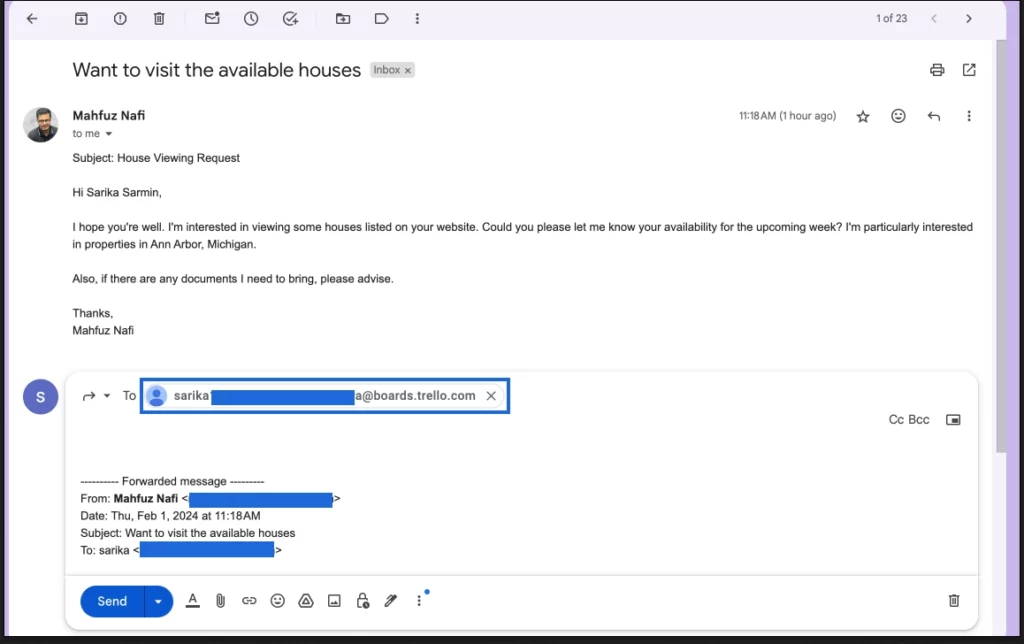
Now, it’s time to see the magic on your board.

10. Learn how to import information to your Trello boards from forms
As long as we’re talking about Trello tips and tricks, you can create Trello cards from a form using a form plug-in if the plug-in has a Trello integration. How cool is that?
We will use Fluent Forms for this example which is super easy to use and comes with tons of features. We can even add cards to multiple lists according to their category from a single form.
To make this happen, first you need to integrate Fluent Forms with Trello. You can do that by searching Trello from Fluent Forms Integrations and enabling the integration.
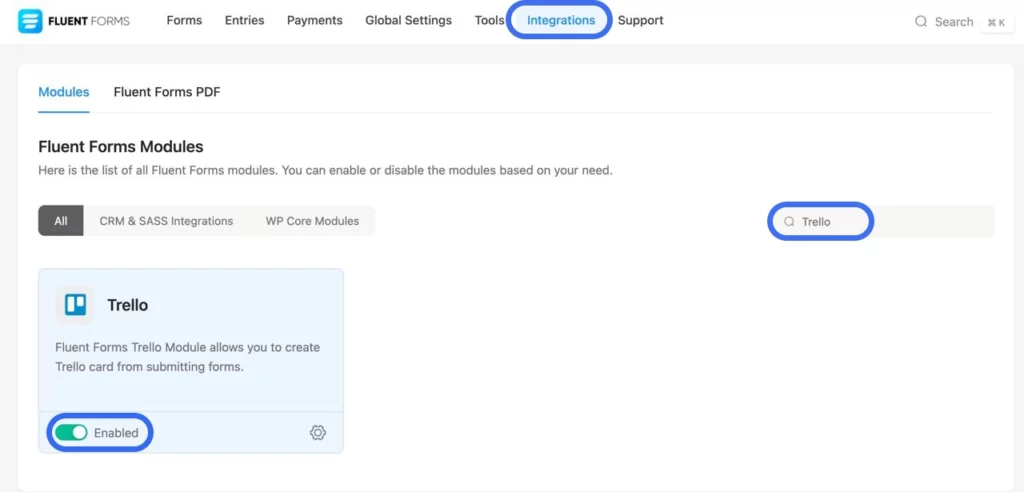
Let’s show you a sample form we created for this real-estate website. We’ve used conditional logic in this form, so when a potential buyer selects the house or houses he is interested in, a new field pops up where he has to put in an amount that he’s willing to offer for that house.
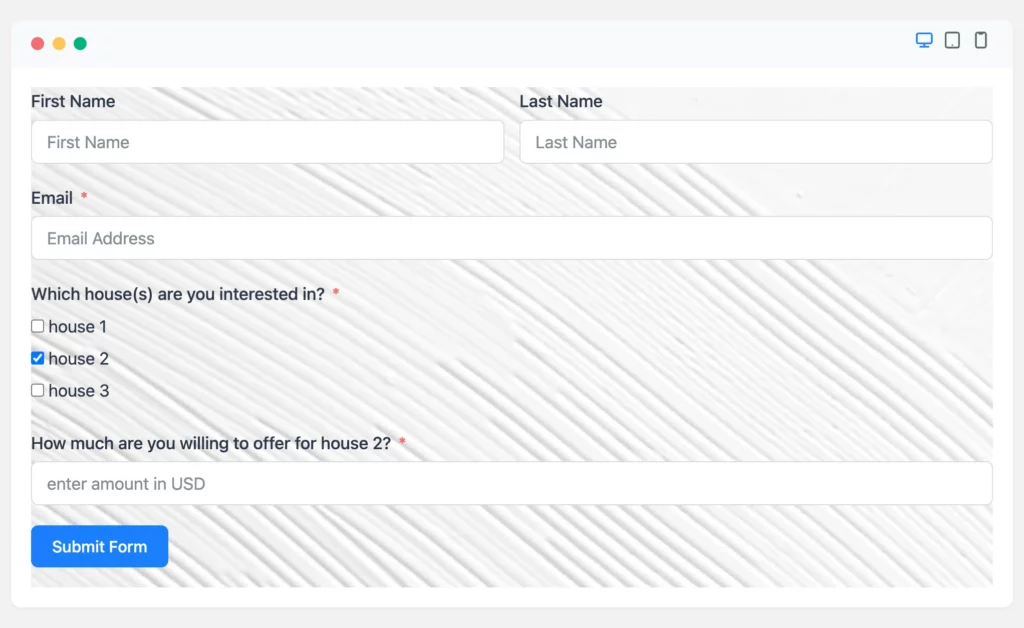
Now, imagine we have 3 different lists on our Trello board for the offers on each house. And we want each offer to go as a separate card to the respective lists. Let’s show you how to do that.
Step 1
Open the form in the editor and click on settings and integrations.
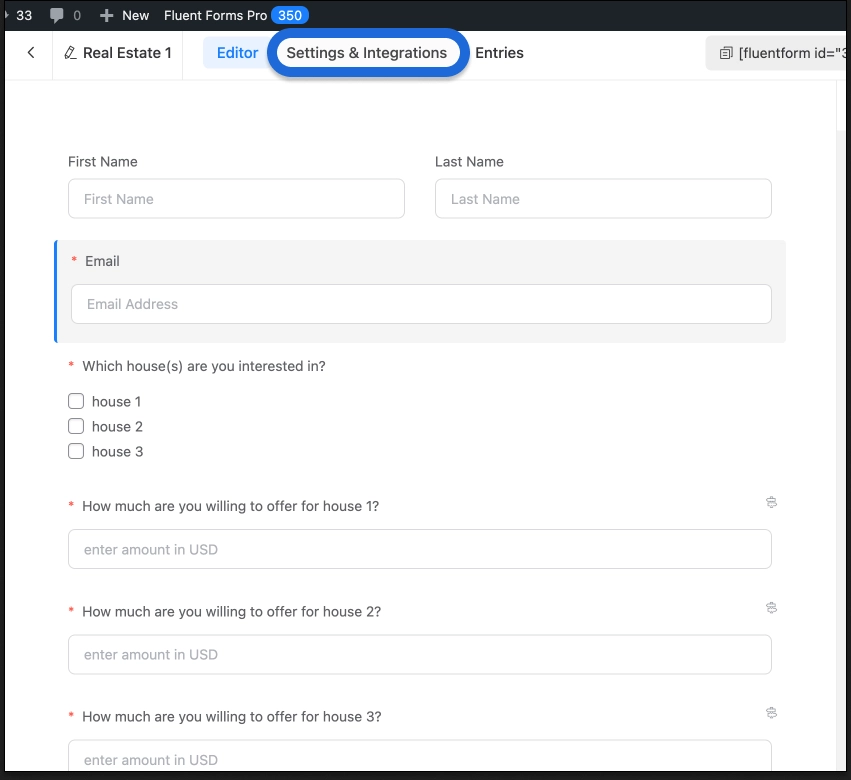
Step 2
Click on configure integrations from the left-hand menu. Then tap on add new integration. Next, select Trello integration from the dropdown menu.
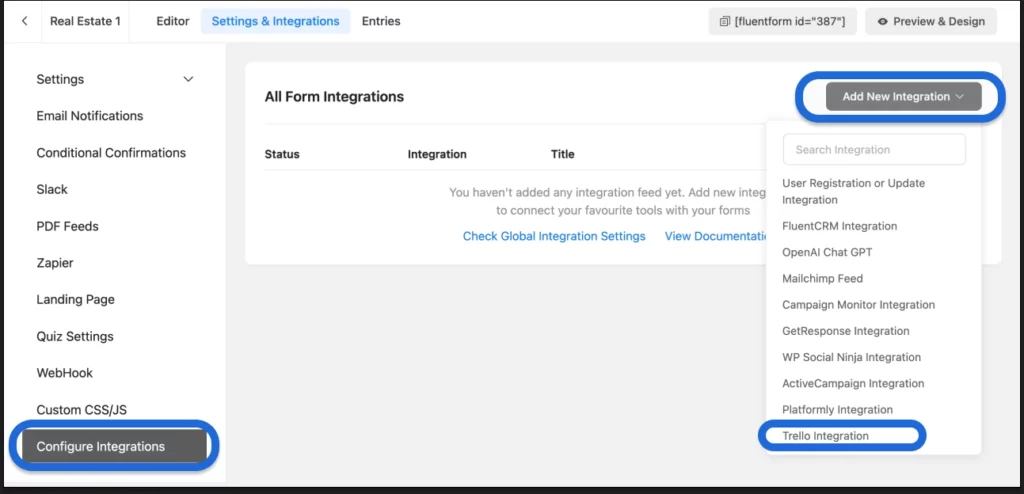
Step 3
This is what the Trello integration page looks like for Fluent Forms. You simply need to fill in the required fields. Like which board and which list you want the form entries to appear in, what you want as the card title and description, etc.
In this integration, we are working on the offers on house 1. Suppose we want the offer amount to be the card title. So, from the dropdown menu, we select the field whose input value we want in the title.
The values for the input fields we select for card content are shown in the card description. We selected first name and email from the icon in the small circle.
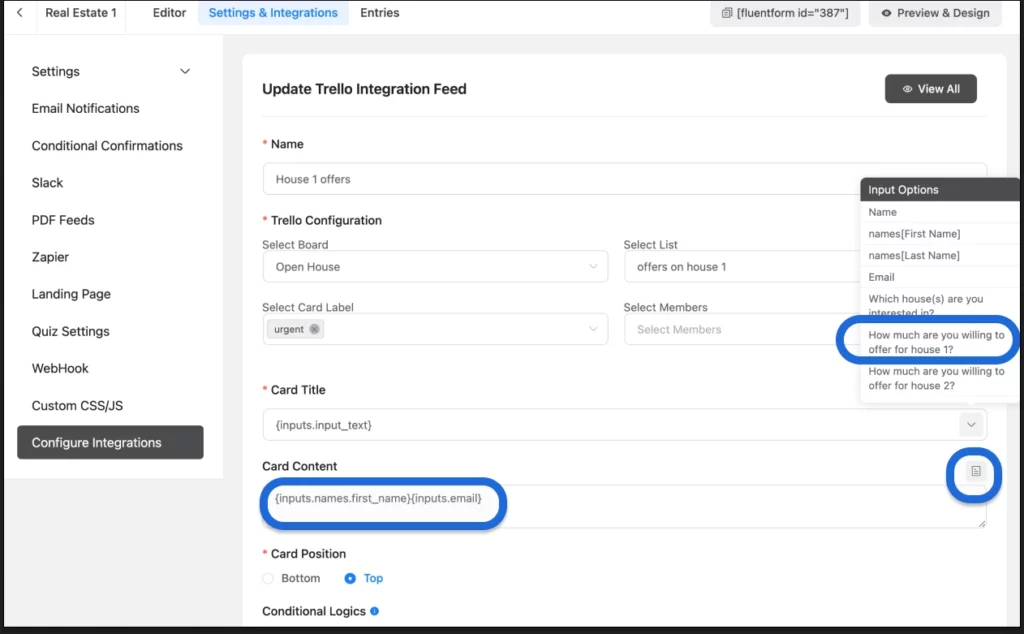
Since we only want this information in the particular card if someone is interested in house 1, we applied relevant conditional logic for that as well. And saved the feed.
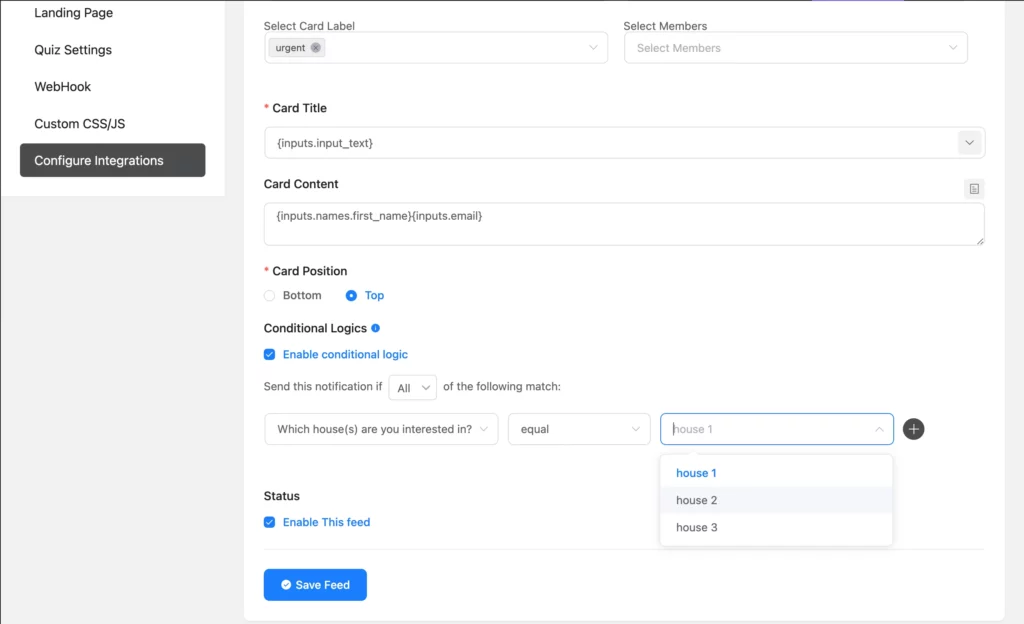
We created feeds the same way for the offers on the other two houses as well, and the integration page now looks like this. The integrations can be edited from the settings icon on the right of each integration.
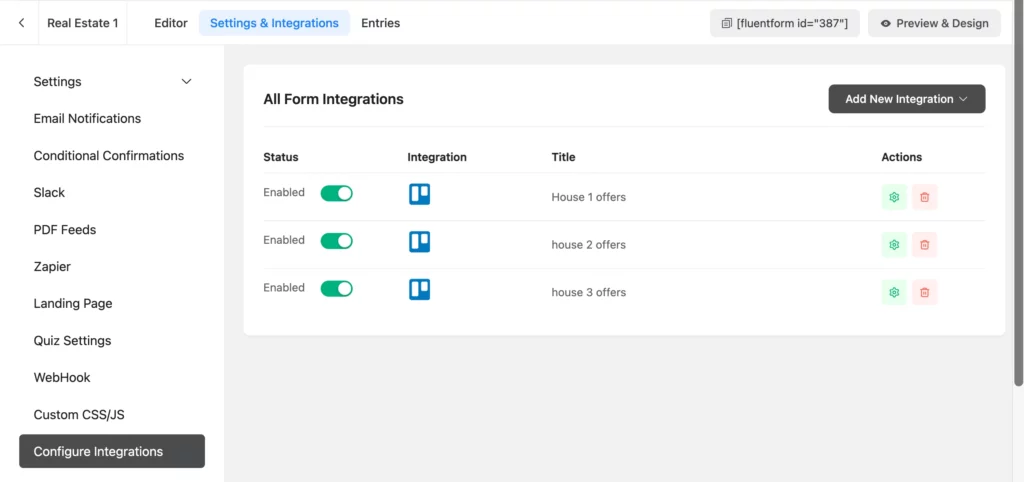
When someone fills out the form, this is what the particular list and card will now look like.
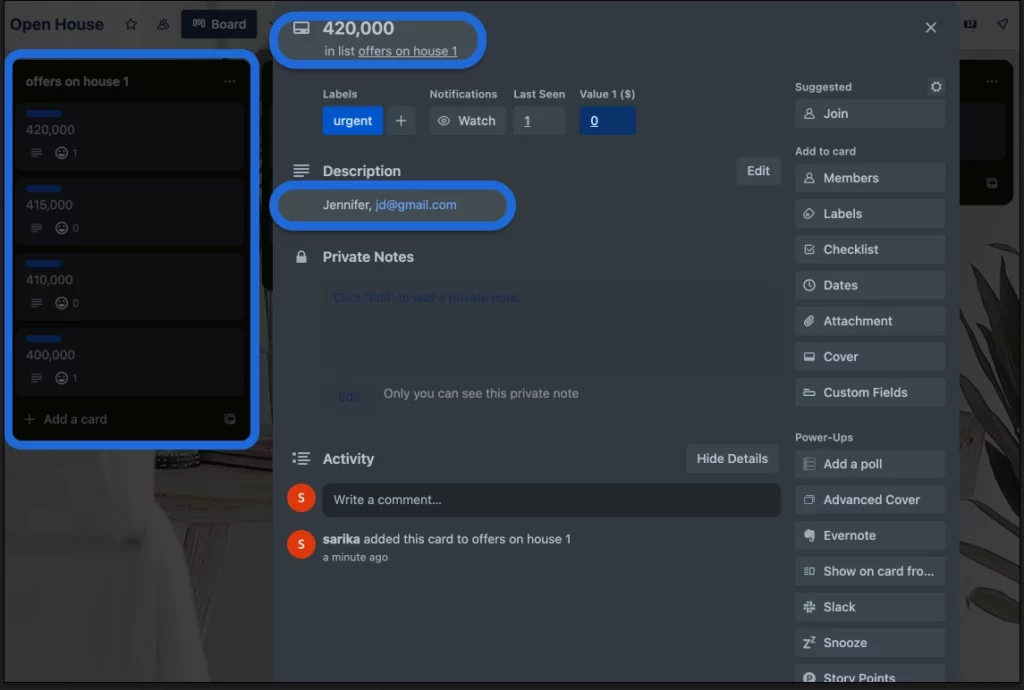
If you’re as amazed by this priceless hack as we are, what are you even waiting for?
11. Track when a card was last checked using this power-up
From power-ups, add “Last Seen” to your board.

Its smiley icon automatically gets added to all your cards and you can see how many people have recently viewed that card. If you open a card, you can also check who and how long ago under the last seen box.
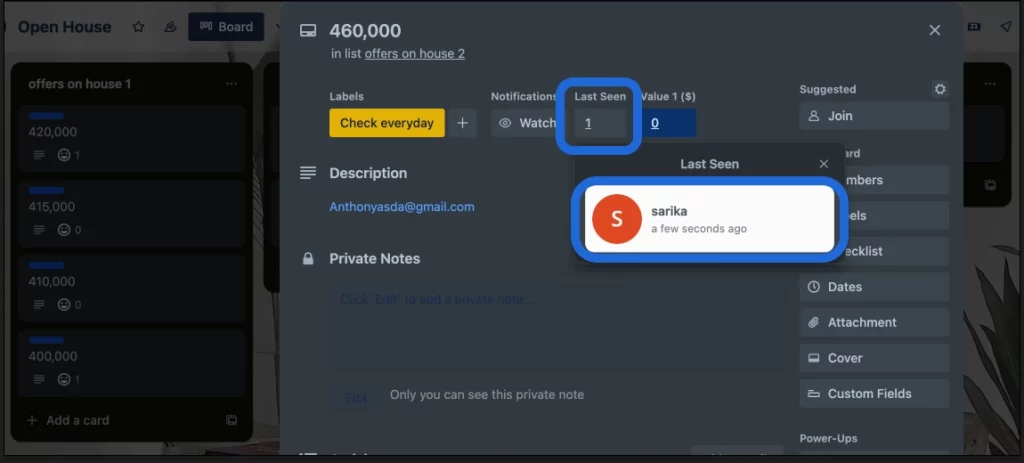
12. Add a private note for self-reminder
Want to check out a cool way to add a private note to a card that no other board member can view?
Check out this power-up – “Private Notes” . It also gets automatically added to all your cards.
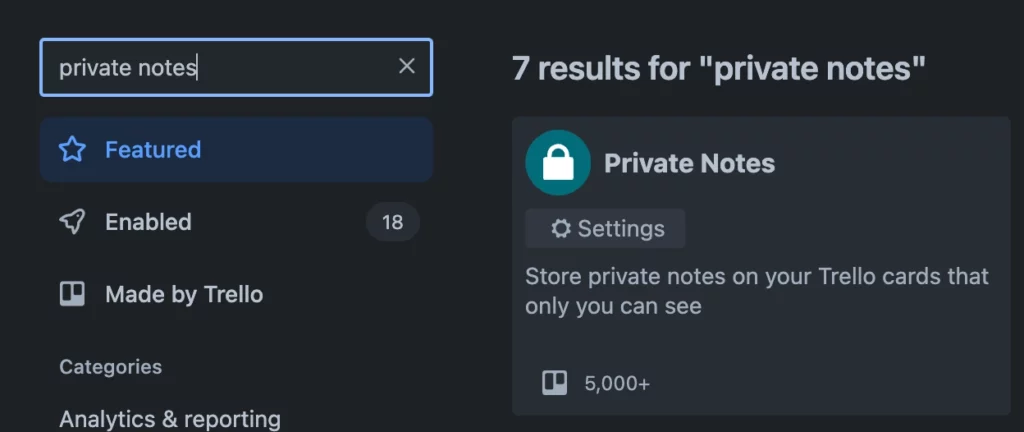
This is what the private notes look like on your cards.
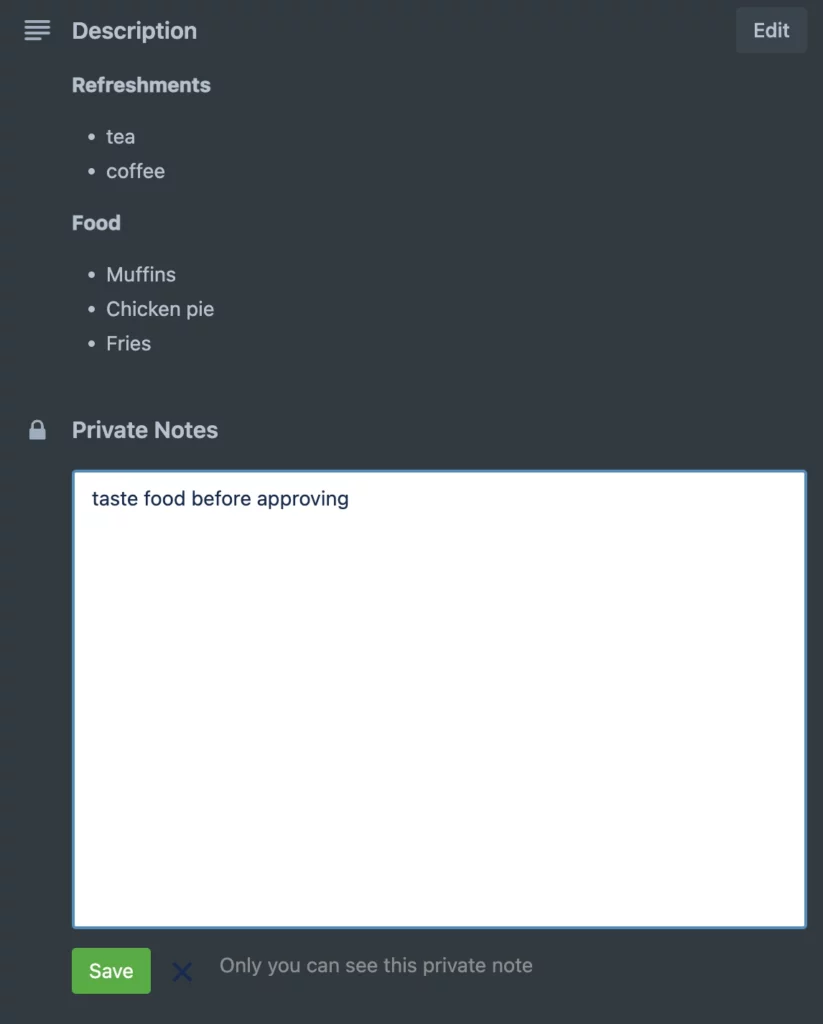
Unfortunately, there is no free power-up for this function. The only bypass to privately add notes to Trello is to create a new board with restricted access and link the new board to the card you want a private note on.
However, please keep in mind that you can never really delete a Trello board completely, and it stays in the archive.
13. Add relevant covers to your cards
Check out how we added the pictures of the houses we want to host an open house at on the card covers.
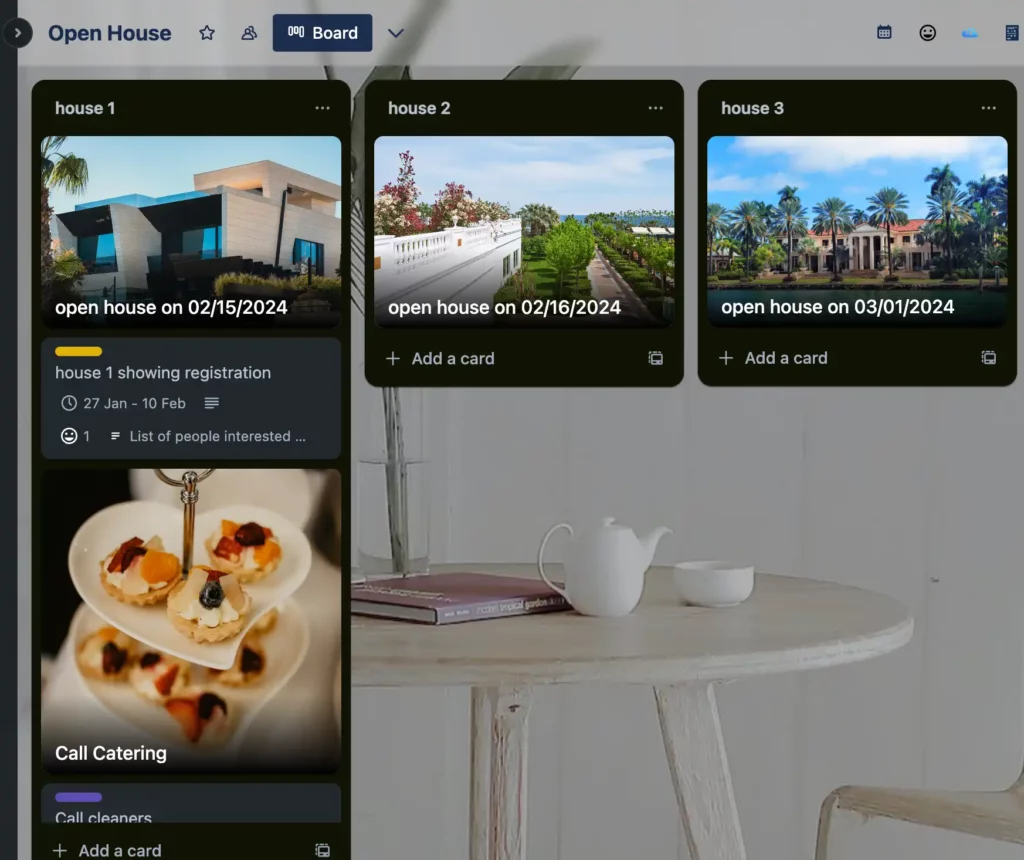
For this, simply open the card and click on the cover. Then, from the menu, go to upload a cover image. You can also use solid colors as your card covers. There are options about the cover size and the text color. Simply select the one you like, and you’re done.
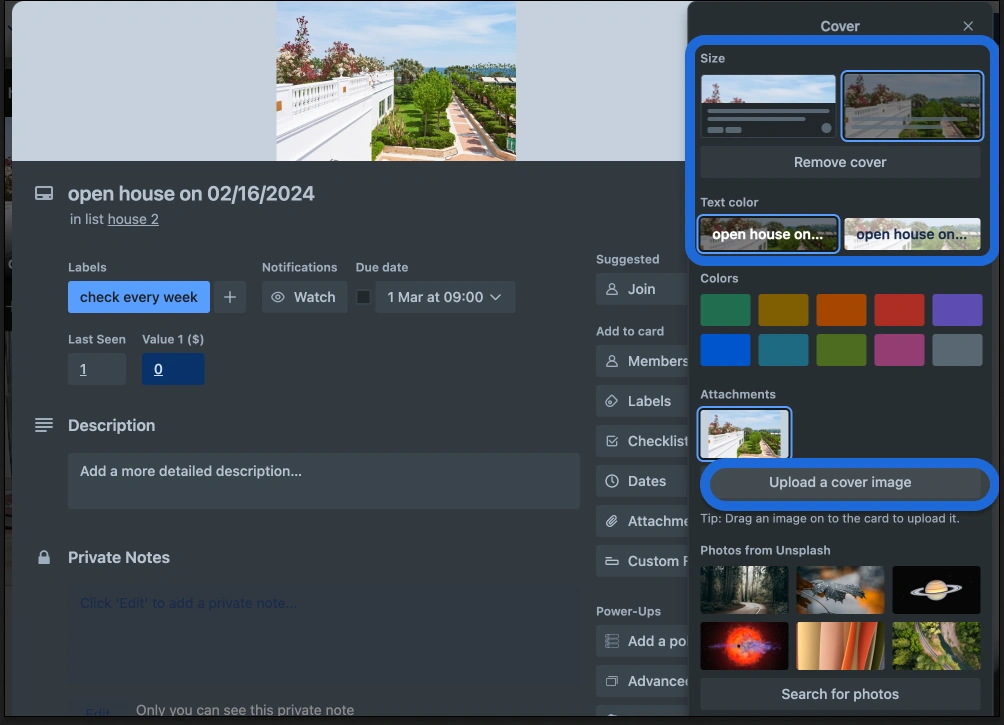
We hope these Trello tips and tricks add value to your knowledge and experience and you can manage your projects on Trello smoothly like a pro.
Conclusion
These are only a few Trello tips and tricks out of its unlimited functions. Remember that this is your workspace, and therefore only about what you’re comfortable with. Go on, explore, and customize everything according to your wish. Make every project a success with efficient Trello project management and run your business tasks smoothly.
What were your favorite trello tips? Tell us! If you have any insight that you want to share or have any questions regarding Trello features or Fluent Forms, don’t hesitate to leave a comment.


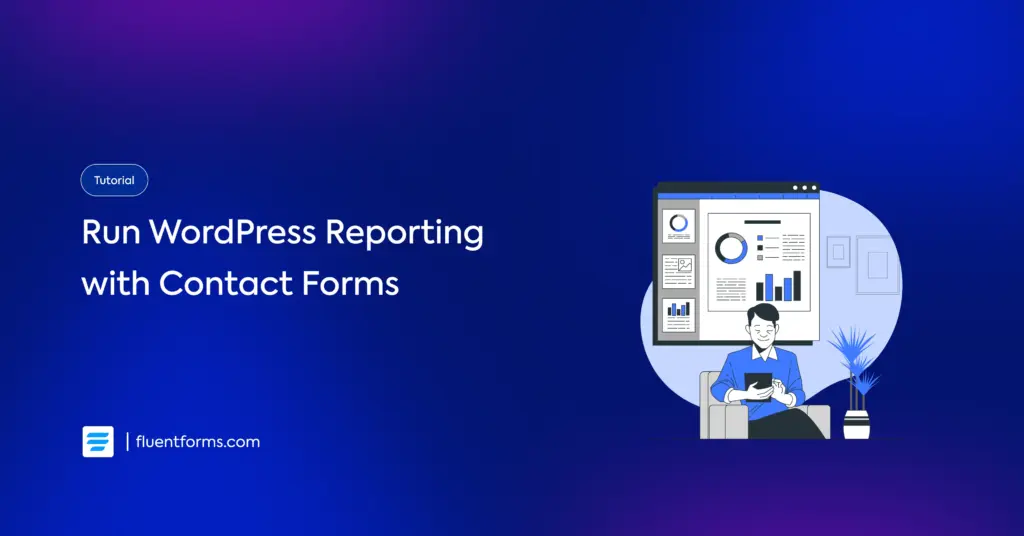




Leave a Reply